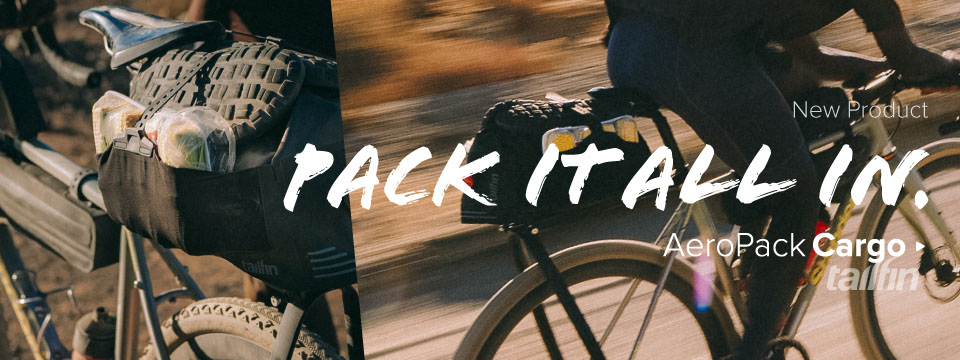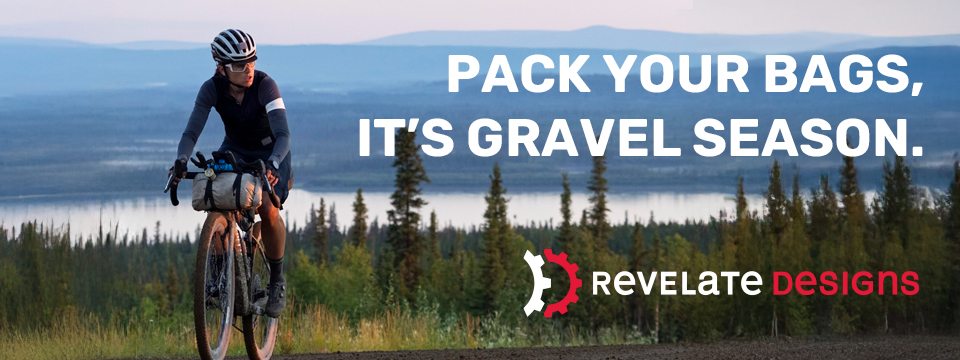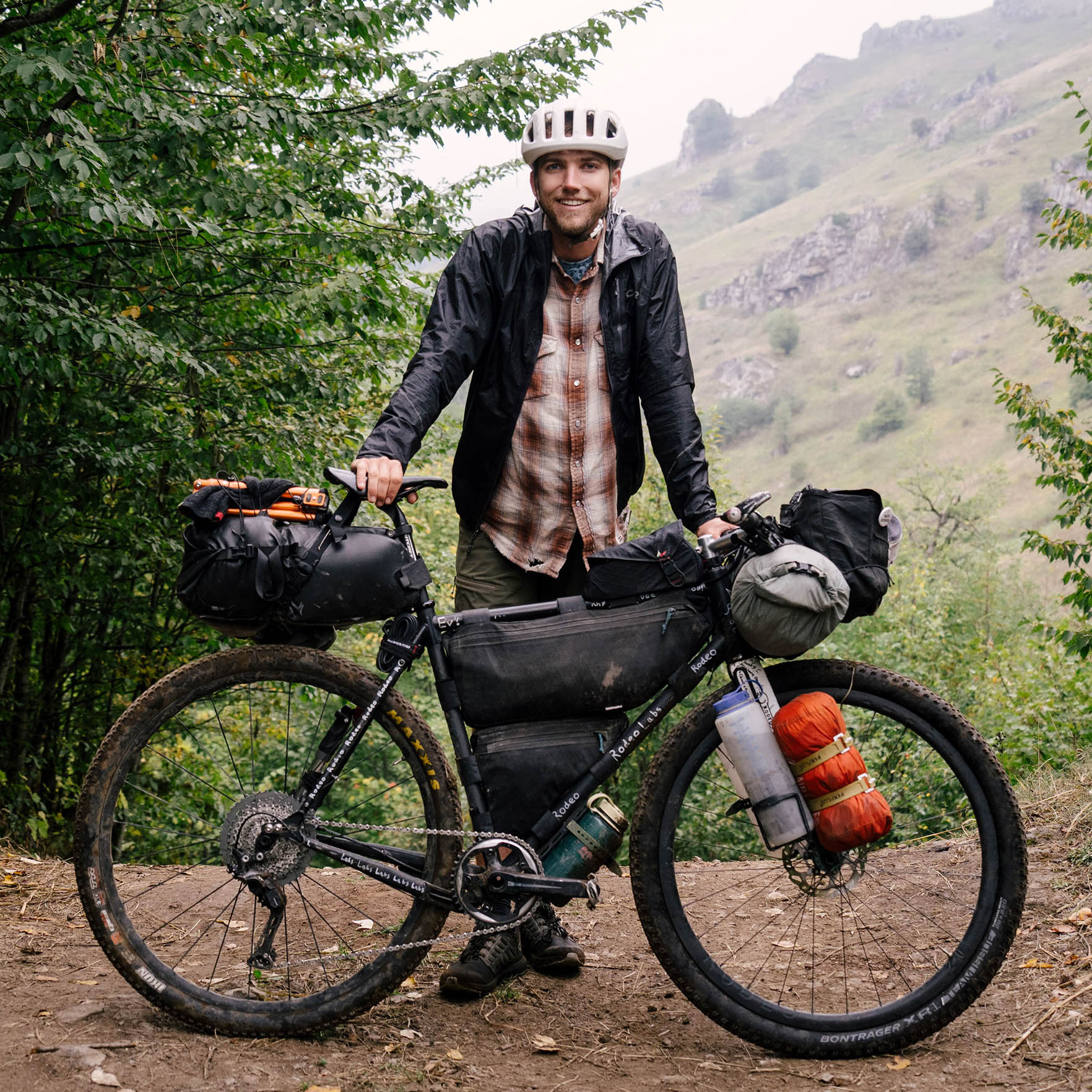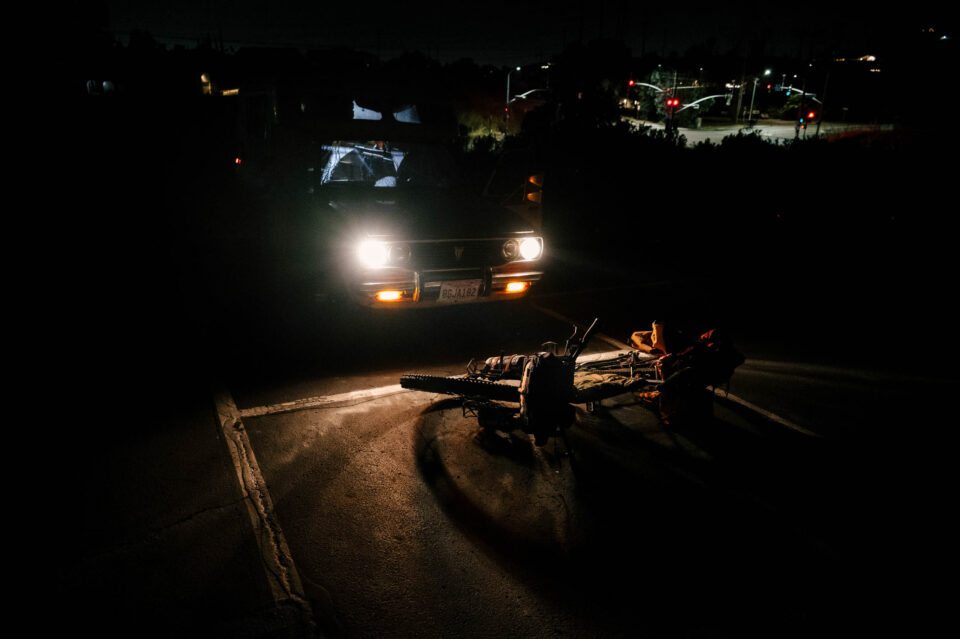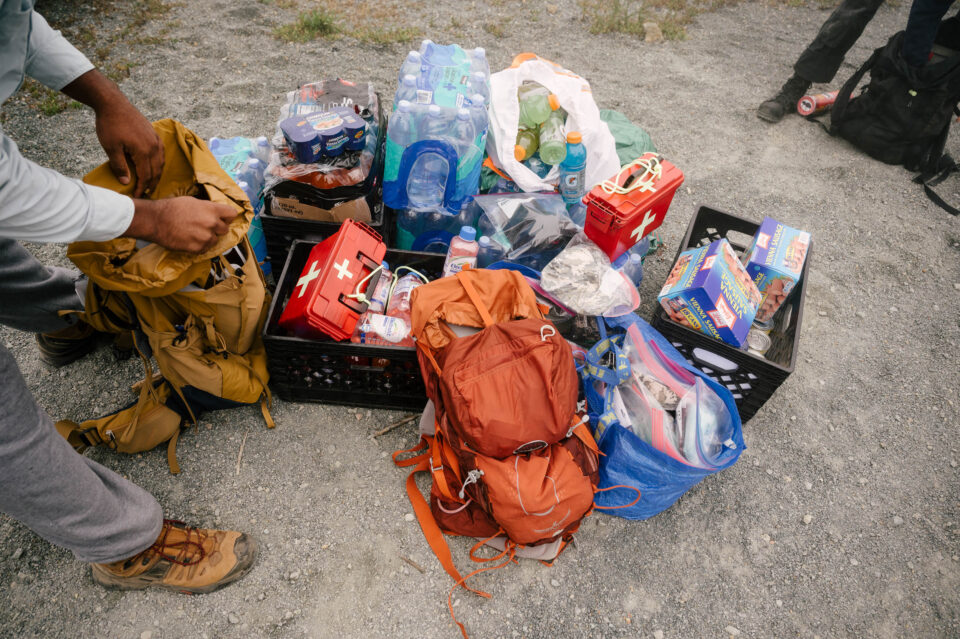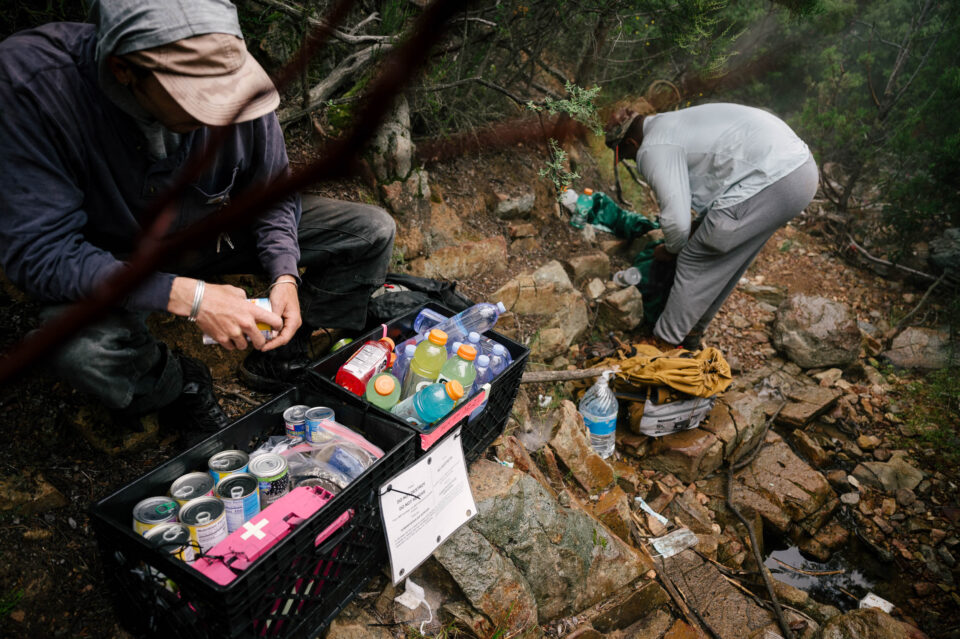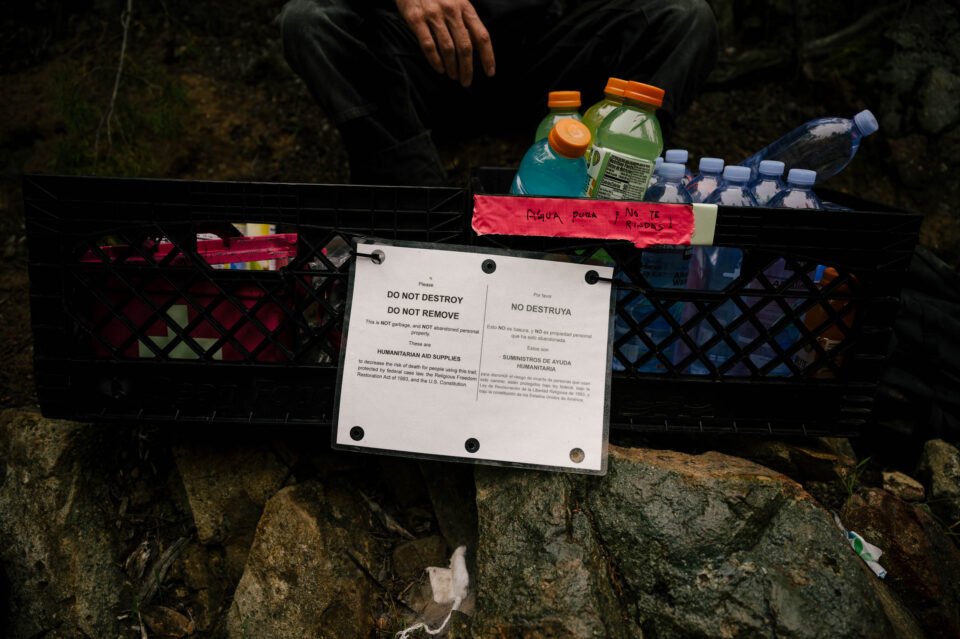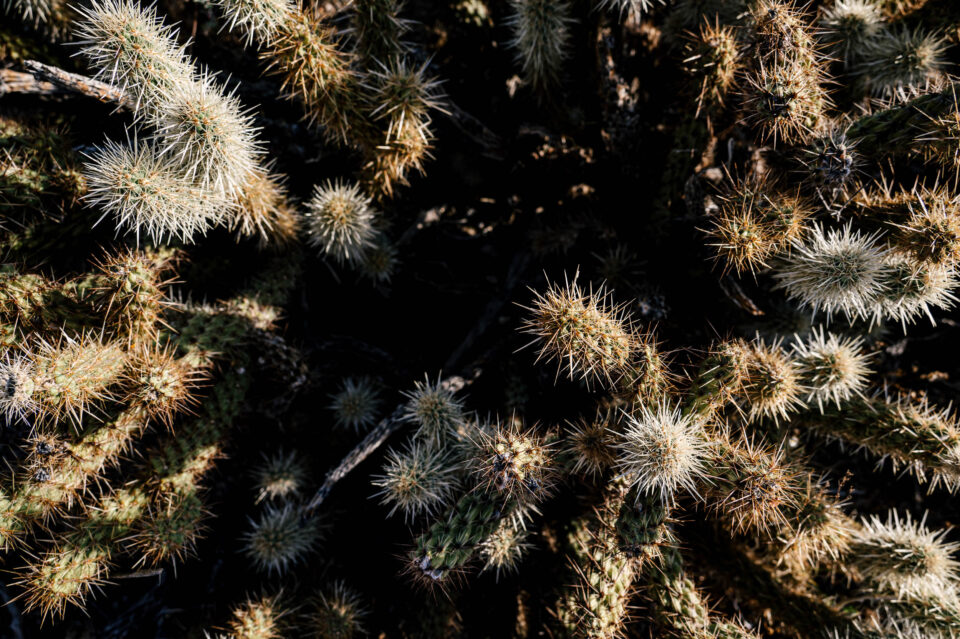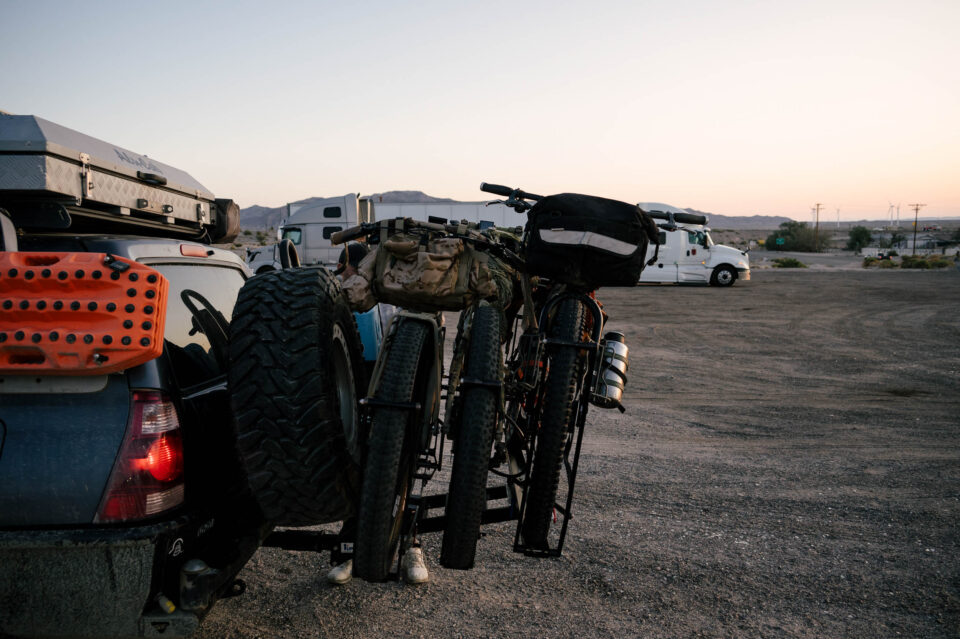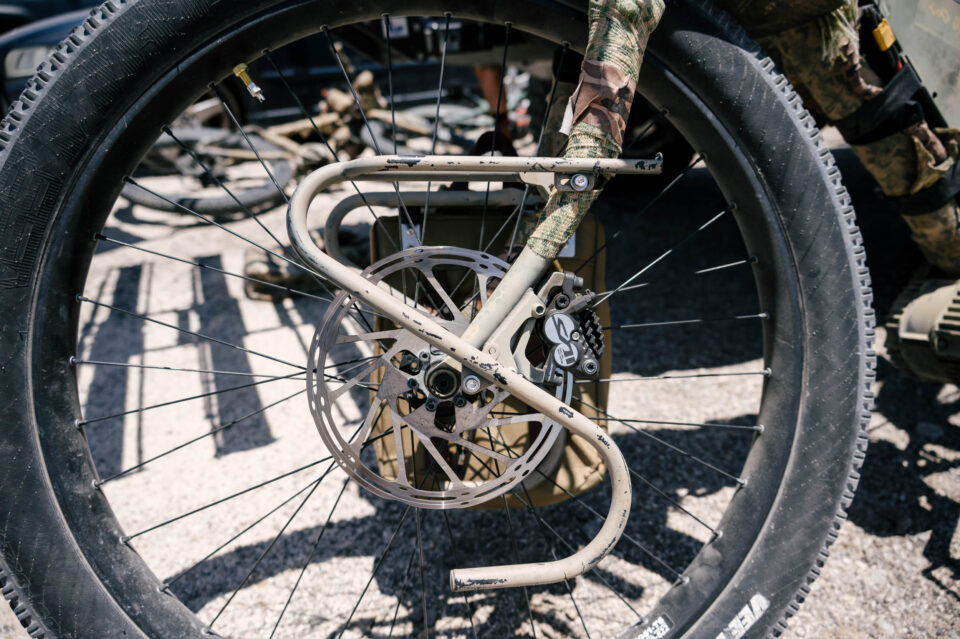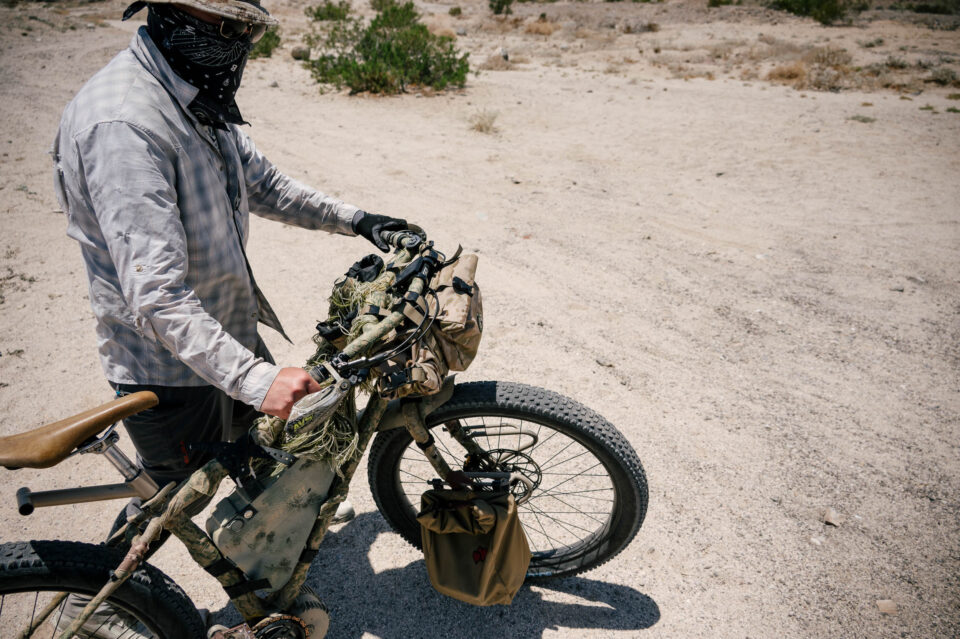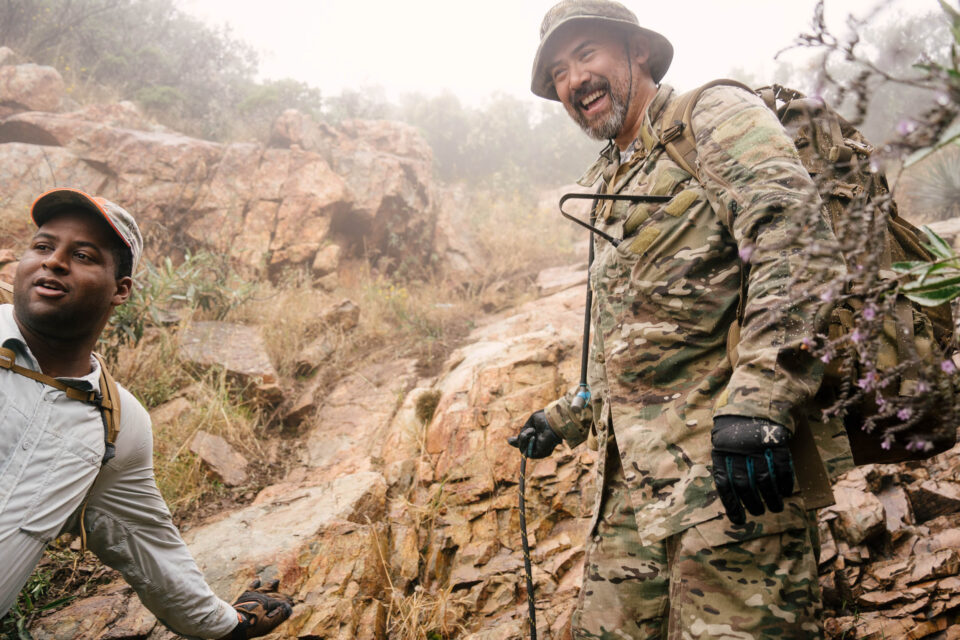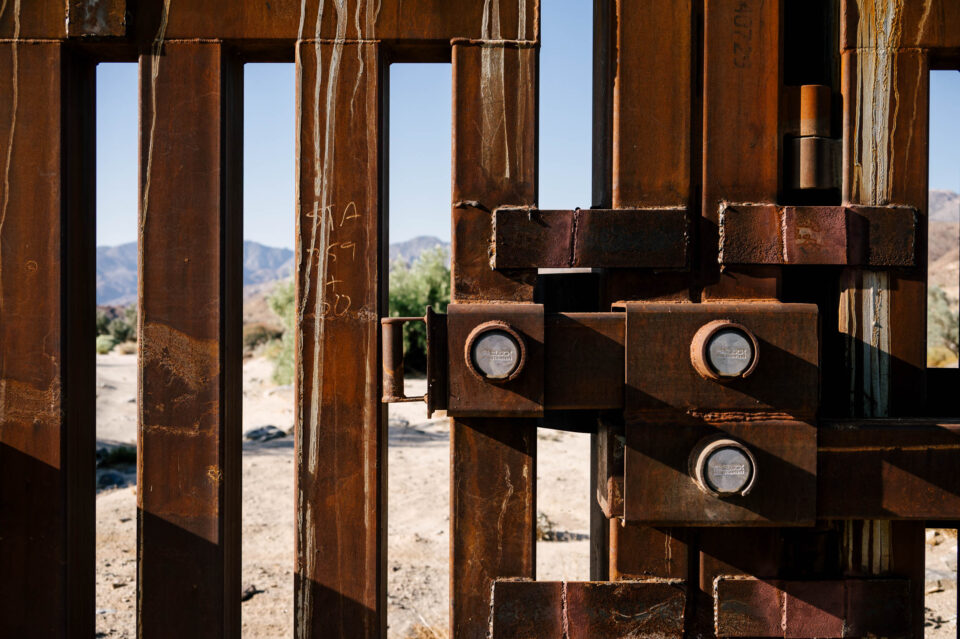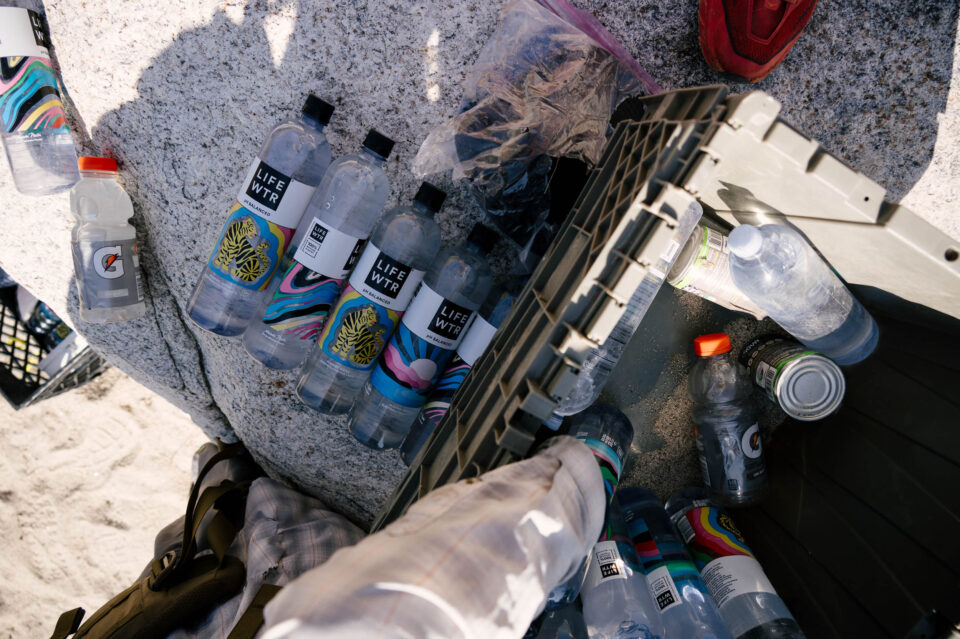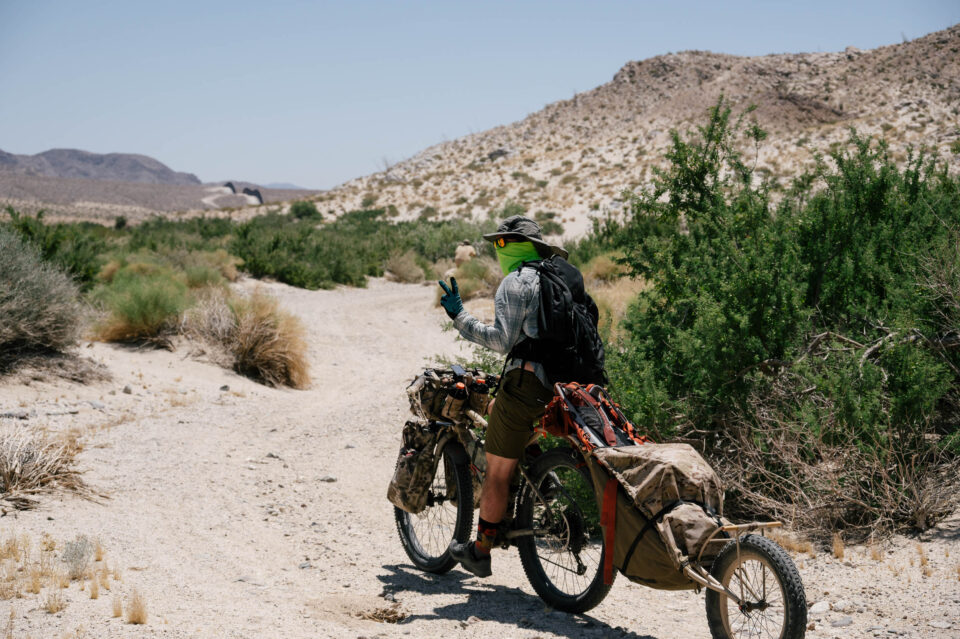A Day with Borderland Bike Drops
For his latest project, photographer Evan Christenson headed out to the deserts around San Diego to meet the people behind Borderland Bike Drops, a volunteer-run group that uses bikes to drop water and supplies for migrants crossing the formidable and often dangerous desert. Read their humbling story and find photos from his time with the group here…
PUBLISHED Jul 12, 2023
Heat builds in the Sonoran Desert like trucks fall off of cliffs. It plummets from the sky and rises from the earth and screams and shouts and fills the world around until there’s nothing except itself. Everything is hot. Our water is near boiling, our food is melting, our saddles are scalding. Intense heat enraptures the mind, isolating and dizzying with its blinding shades of white.
We’re up at 3 a.m. and here early, on the bikes by sunrise, and the sweat erupts from my skin like the sun erupts from the night. In a few hours, it’ll be over 100 degrees, and for months on end, it’ll stay that way. David talked about the project the whole way over, the warm glow of the looming sun pulling us east, the cold spurts of border patrol search lights warning us of our passage. The bike rack squeals under our three loaded behemoths the entire time. I’m nervous to set out. But David isn’t new to this. His memories are cut deep. The emotions flood him as the mountains unfurl and the rising sun lights the sky like a candle. He’s been to this desert over 100 times now. He knows these hills and these footpaths. And he knows they’re all filled with death.

David helps run the bike drop team of Borderlands Relief Collective, a fully volunteer run organization based in San Diego that drops supplies along the border in hopes of reducing the risk of injury and death among migrants passing through. David’s a fun guy, jocular and giggly, highly educated, and very direct. Within this world of darkness, he appears both locked in and at ease. He chuckles while he talks, whether it’s serious or not, as if it’s an essential method of coping. David decided to pursue medicine after a stint traveling the world in his 20s. He studied at Rutgers and Cornell and finally moved to San Diego to take a job as a general surgeon in a nice hospital here.
After growing up in New Jersey, then living in the bustling metropolitan webs of New York, Taipei, and Chicago, and spending time in the jungles of India and Bangladesh, San Diego offered something completely new. The cool pine forests of the mountains and vast desolation of the deserts fascinated him. He studied anthropology in college, and was sucked into the deep and rich history of the Kumeyaay that first roamed these hills. He learned their stories along hidden crevices and arroyos, stories from long before borders were even an idea. San Diego felt like a playground to David. He bought a truck, laced up his boots, and started adventuring.
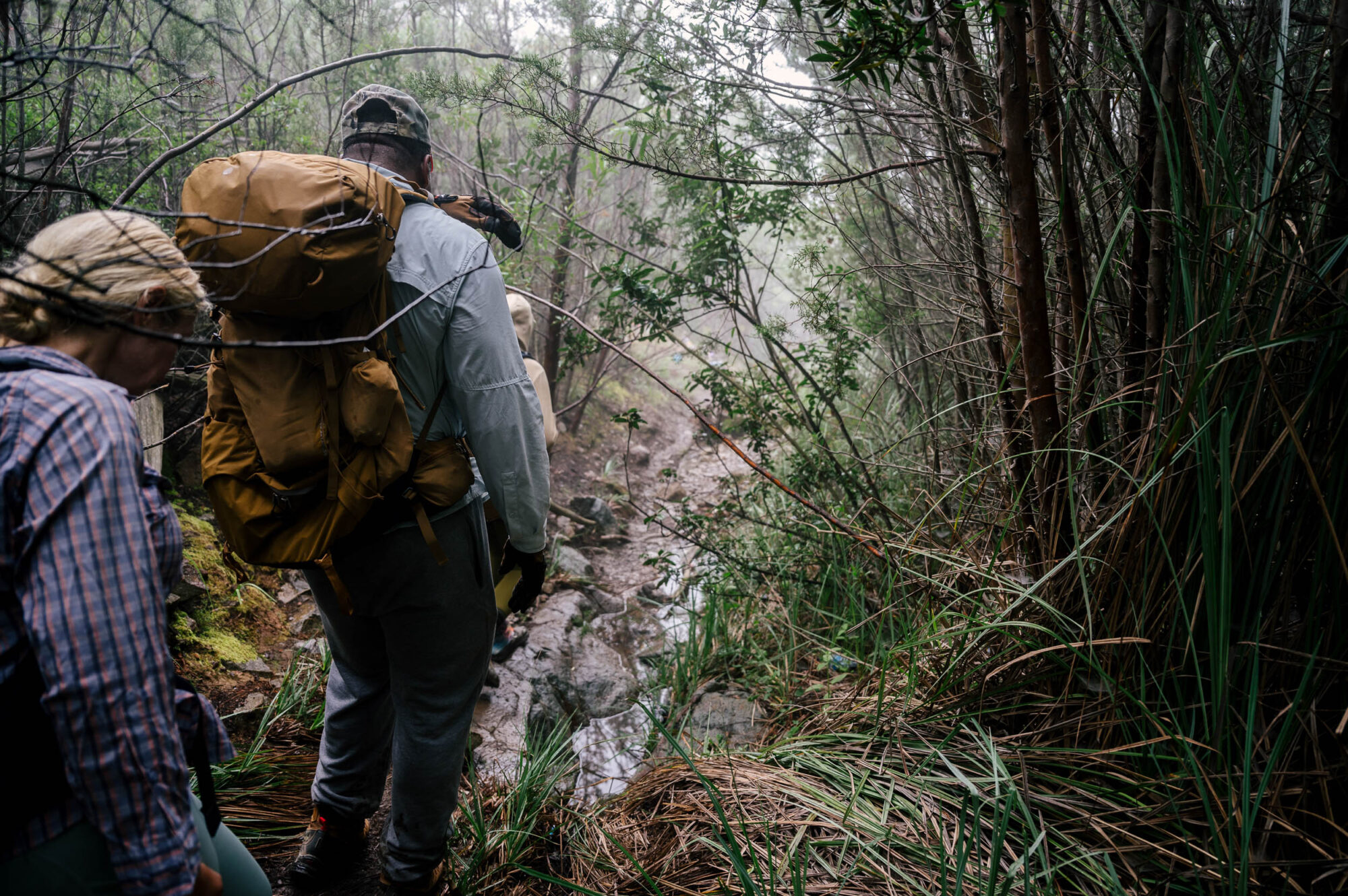
As we drive down Interstate 8 together, the “Kumeyaay Highway,” a road I’ve driven hundreds, maybe thousands of times, David points out all the small nooks he’s hiked and biked out to. Mud caves and cold springs and rock shelters and Indigenous heritage sites I’ve never even heard of. While out scrambling through these places, he started finding old backpacks, abandoned shoes, torn clothing, water bottles, candy wrappers, and rusty cans. He traced nervous northbound footprints along the sheltered washes. David realized there was another layer to the stories being told by these places—a story much more contemporary and just as tragic. He got involved with the Border Angels and started heading out to the desert to drop water and supplies off for the people crossing this land.
After a couple of years spent volunteering with the Border Angels and working with other groups, he took his family to the desert to search for petroglyphs. It was just after Thanksgiving Day in 2020, and while hiking through the canyon, David found the pelvis bone of a small child, abandoned and somehow isolated in the seemingly empty canyon. And after continuing on, he ran into a migrant, crossing not north but heading back home to Mexico after spending time with his family in Riverside for the holiday. Several crosses stand alone in remembrance in the canyon, rusting away with their prayers engraved in Spanish. David saw these, the rugged nature of the area, and the evidence of traffic, and he felt the need to drop water into this empty stretch just after the border. They began designing routes around the crosses dotting the hillside but were immediately hassled by Border Patrol. A helicopter circled them within throwing distance. Agents on the ground said what they were doing was illegal. David knew it wasn’t. He pushed back. “Look at me. I’m a US Citizen. I was born here. I’m the Chief of Surgery at Sharp Hospital. They’re not going to arrest me. I can push the boundaries a little,” he told me.
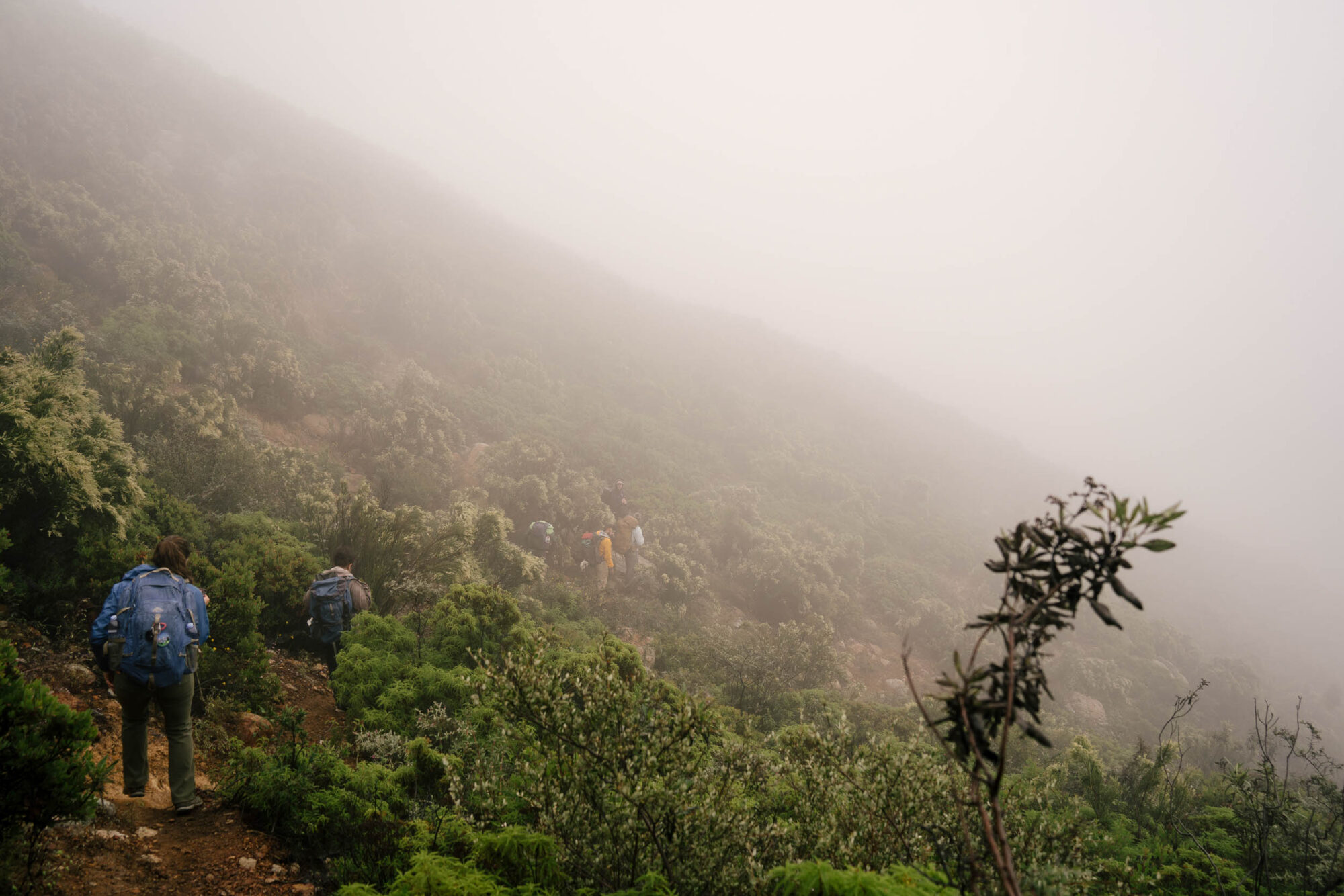
David and I sit together later, sharing a beer and talking about the world he’s quickly immersed himself in. We sit with a view of downtown San Diego, the planes and the skyscrapers jockeying each other for position in the salty ocean breeze, and he looks back on his first motivations to get involved in humanitarian work. “The idea that in the year 2023 in California, which is the richest state in the richest country in the world, just one hour from downtown San Diego, people are dying of hypothermia or hyperthermia is just unacceptable. It’s fucked up.”
Another plane screams overhead, tourists wander down the road, a cosmopolitan couple poses for a photo near the water. We’re layers removed from the world of tragedy just a few miles away. David looks down and keeps talking. “That’s the motivating thing for us. It’s something that’s hard to even get your brain around. And once you have these up-close encounters, it’s just like… holy shit. I’m standing where someone died… or you’re finding things. The jeans of a woman who died… it’s like… this is real. This is something important I want to get involved in.”
In 1994, amid growing political pressure from its constituents along the border, the US Government announced Operation Gatekeeper. Certain people were fed up watching families run across the small chain link fences that separated Tijuana and San Diego. Crossing back then was easy, few officers observed the border, the line was mostly just that, and it led to a whole wave of workers crossing illegally into and back out of the US each day. There’s endless stories of people walking across to grab a bite to eat, go shopping, spending an afternoon with their families on the other side, and then walking back to Mexico. But the Clinton Administration changed everything. They took heaps of surplus steel left over from the Vietnam War and built up a massive wall separating San Diego and Tijuana. They hired thousands of Border Patrol agents, weaponized them, gave them cutting-edge surveillance technology, and lined them up shoulder to shoulder to watch and arrest anyone trying to cross the border illegally. And it worked. In the decade following Operation Gatekeeper, illegal crossings in San Diego dropped by 72%. It was hailed as a victory. A statement was made, and the constituents moved on.
The migrants moved on too. They went east. Because what all this didn’t do was actually stop the crossings, it just pushed them out to the desert, where people were less likely to notice, and where it was impossible to patrol. Desperate people will always do desperate things, and the underworld business of coyotes and human smugglers popped up to fill the growing demand. They began guiding walkers through the desert passages far east of San Diego, into the mountains, through large desert plains, and at night along exposed jagged ridges. They went underground. They went further out and hiked longer distances.
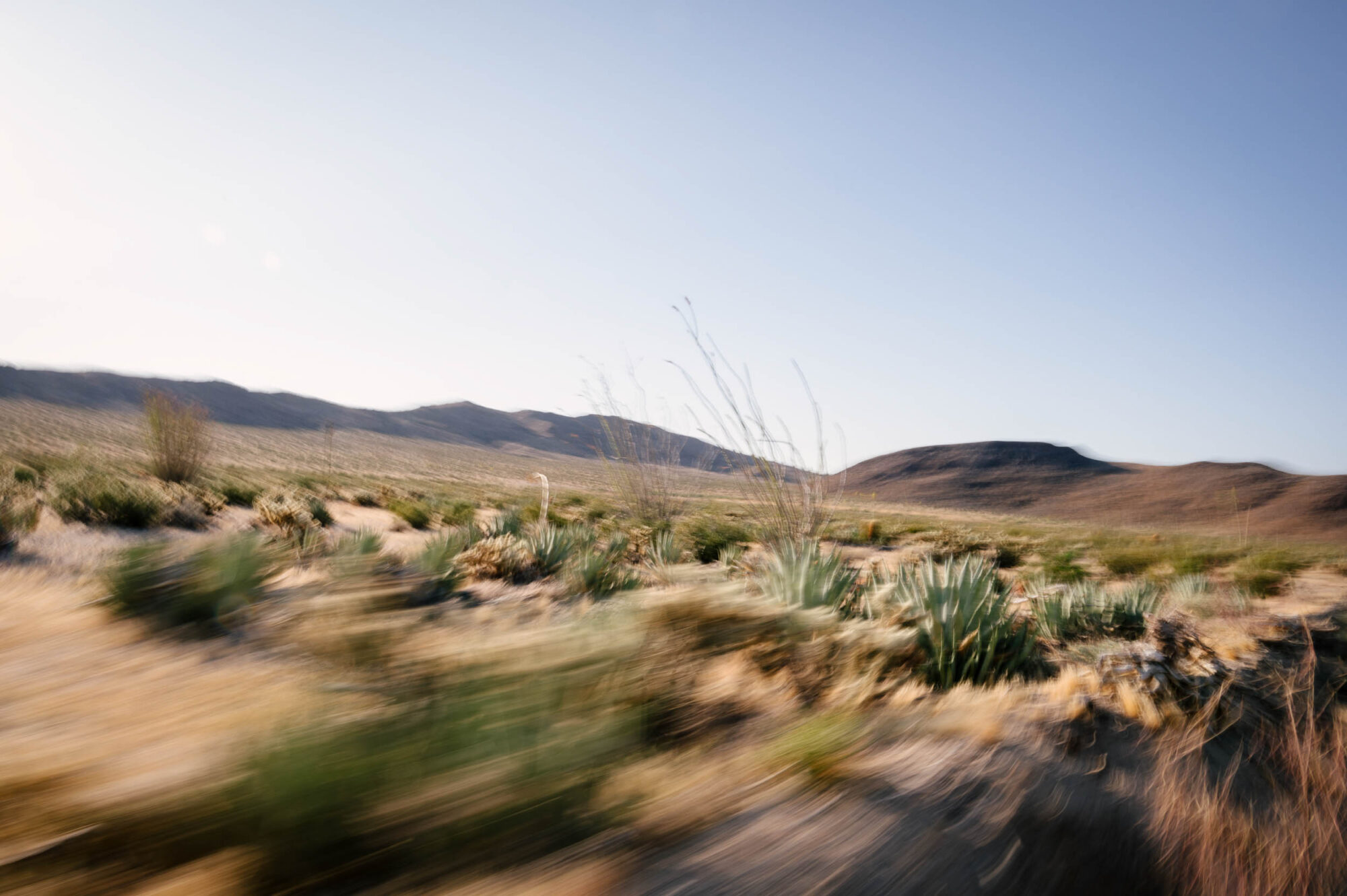
The numbers of crossings in the Tucson district, the large swath of Sonoran Desert east of San Diego that’s impossible to patrol, went up more than 500% between 1994-2004. And what this has really done is made the entire operation much more dangerous. By driving migration routes into the desert, using the “Prevention Through Deterrence” technique, migrants now face long and perilous journeys that often expose them to elements no one can prepare for. Intense heat, no water, no shade, rattlesnakes, falls, violence. Various estimates place migrant deaths at 7,500 to 12,000 in total. According to the official Border Patrol count, 853 people died last year while trying to cross, and surely hundreds are still left uncounted. It was the deadliest year to date. And now, the United Nations considers this the most dangerous border to cross in the world.
Back in the car, David drives on. “At first, it’s a little abstract, you know? It feels good, it’s an adventure, and you meet nice people. But then you go back and you see that the supplies are gone, and new people have come through, and you realize that this stuff is actually needed. And then you meet migrants in need and then it becomes a whole different thing. Like, those migrants we saw getting arrested last weekend. And then it becomes about death. About preserving people from death. We’ve designed these routes and we’re going to these places explicitly because we know people have died there.” David talks fast and direct, and he keeps his eyes locked onto the desert looming in the distance.
I ask him how much of this fills up his brain. He knows endless things about migrant patterns and statistics and terrain. “A lot. Most of it,” he admits. David feels the burden of this moral obligation he’s stumbled into. When it snows in the mountains, he’s no longer excited to take his dog to play. He thinks instead of the tragic stories he’s encountered and worries for those still unprepared for the elements. He’s carried hundreds or thousands of gallons of water up mountains on his back. Earlier this year, he had surgery on a herniated disk he says was most likely caused by these carries. He brings his son and daughter out on drops. He’s involved in the community and organizes and buys a lot of the supplies himself.
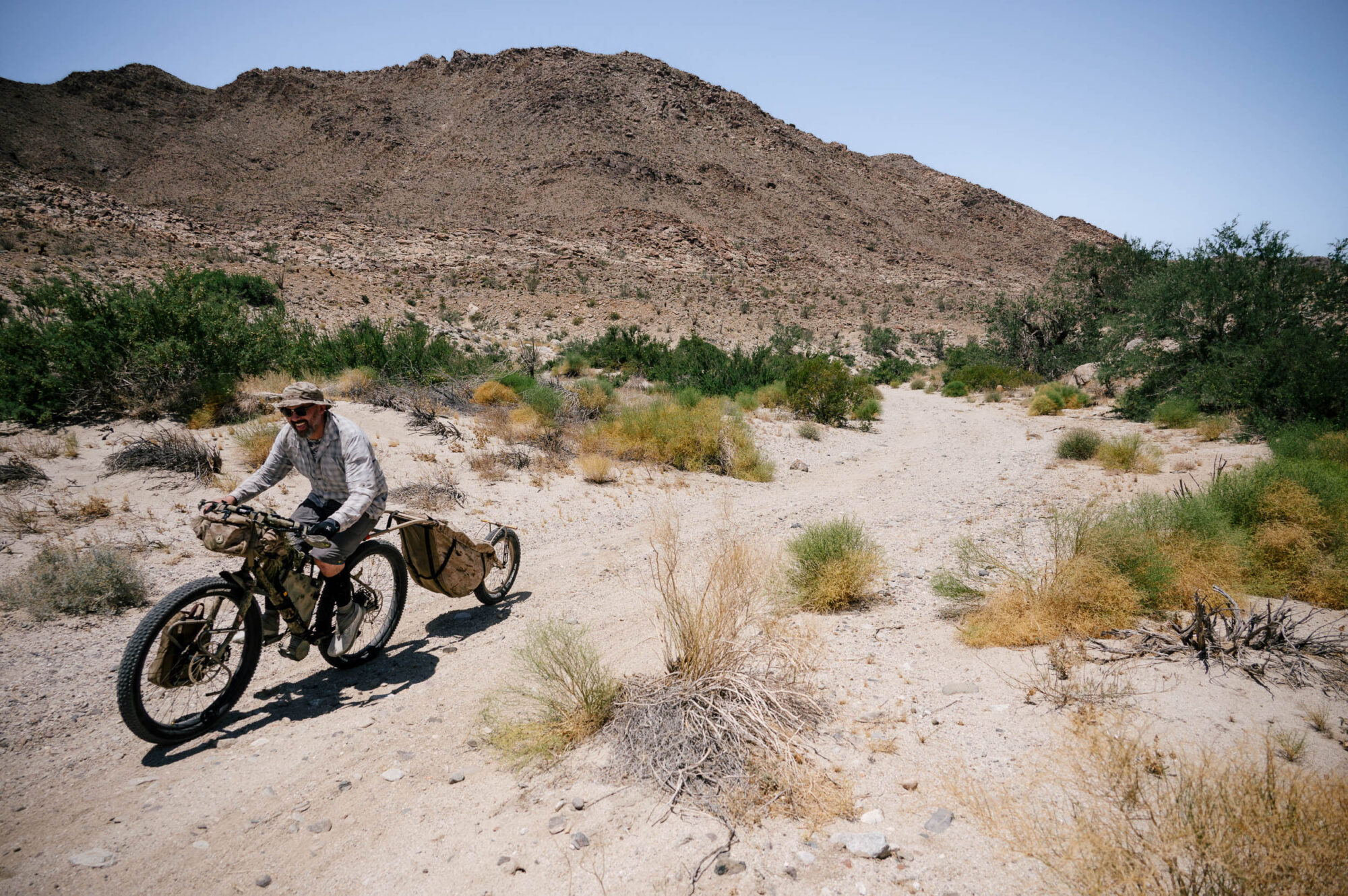
I met David the weekend prior at a drop at Otay Mountain. The group regularly drops water and supplies along hidden footpaths that lace through the canyons, going up and over the steep mountain on the border, the only truly rugged section of the border in San Diego proper. We drove along the Baja Divide route to get there, and we hiked off the fire road I’ve ridden dozens of times. Discarded backpacks and bottles of water and shoes and papers mark the trail straight to the border. Lately, they’ve been finding torn up documents from Turkey, Uzbekistan, and Afghanistan among the scattered South American papers. Even Turkish translations of Kafka and Dostoevsky lying abandoned on the trail.
These footpaths wander among an ecosystem I’d never realized existed, hidden among the bushes whizzing by as I naively pedaled by. Every crate they stopped to resupply was empty. Sometimes, while hiking back up, they realize people were hiding in the bushes, and have already used some supplies by the time they return. I was shown places people are known to sleep, and where the Border Patrol recently slashed a crate of water bottles, an act that forced the previously underground Borderlands Relief Collective to go public.
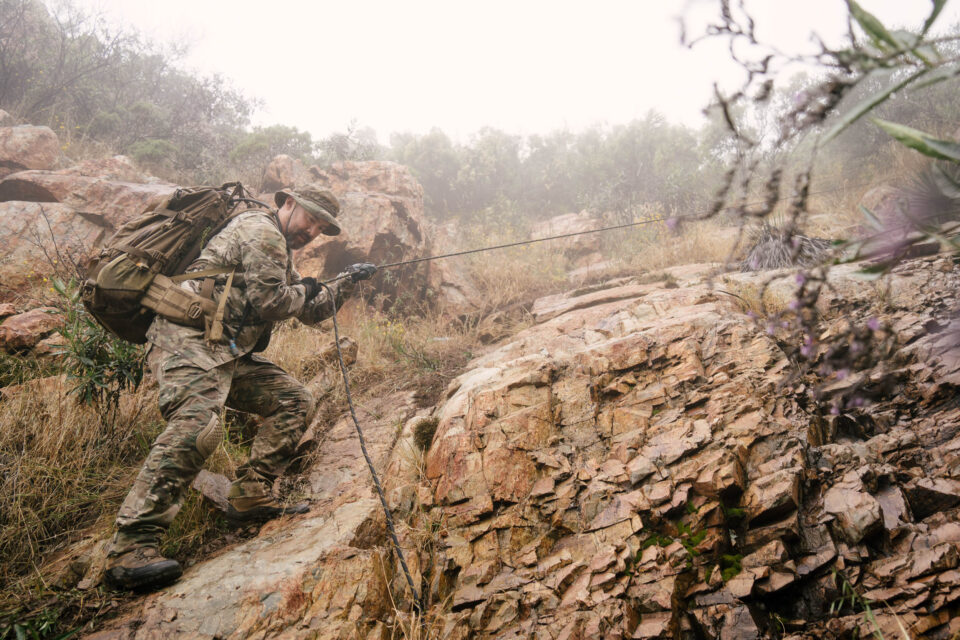
Two passing cyclists see migrants running across the road and diving into the bushes. We’re told to stay alert for people, but no one crosses our path. The trails are steep, loose, and wet from the heavy June fog. We rope in to repel down an especially steep section, and we stoop low and cling to worn roots as we crawl under the cover of chaparral. It’s another regular weekend for the group. They jump quickly back into old conversations and laugh together over common stories. To me, it feels like chaos. Like running from a pursuer. My back stoops low under the weight of the cans of chili and tuna, and in the bushes, we’re blind to see what’s next. Rocks collapse under us, and we cling to wet roots while scrambling up the hillside. I think how David is right. It all does feel a bit abstract.
Finally in the desert, we load up the bikes and set out into the void. I’m dropped off first, and I pedal on in silence, weighed down by the gravity of this land, keenly aware of the desolation. The desolation is intense, the jagged mountains funnel the throbbing desert wind as it billows hot sand. Cacti prod at the iron rocks that crumble and collapse under themselves. The blinding heat bleaches everything into shades of gray. I squint at the orange and gray flowers and the blue and gray sky, my sunburnt skin and the white sand. Jackrabbits scurry along drainages, red tailed hawks and buzzards soar on the currents overhead. Their shadows dart along the ground, in and out of focus, a reminder that life in fact can exist out here.
Life here feels impossible. This land is too alien, too mean, too brazen. My body screams to get out while the heat continues to build. I pedal on, and the desert opens up, nothing but rolling hills and faded washes from here unto the horizon. A silence falls upon me, so crushing, so massive, like deafness in my ears. I surrender to solitude. A line appears in the nothingness. The wall, alone, in the vastness of space and time. Alone in the sand. Alone in astonishment.
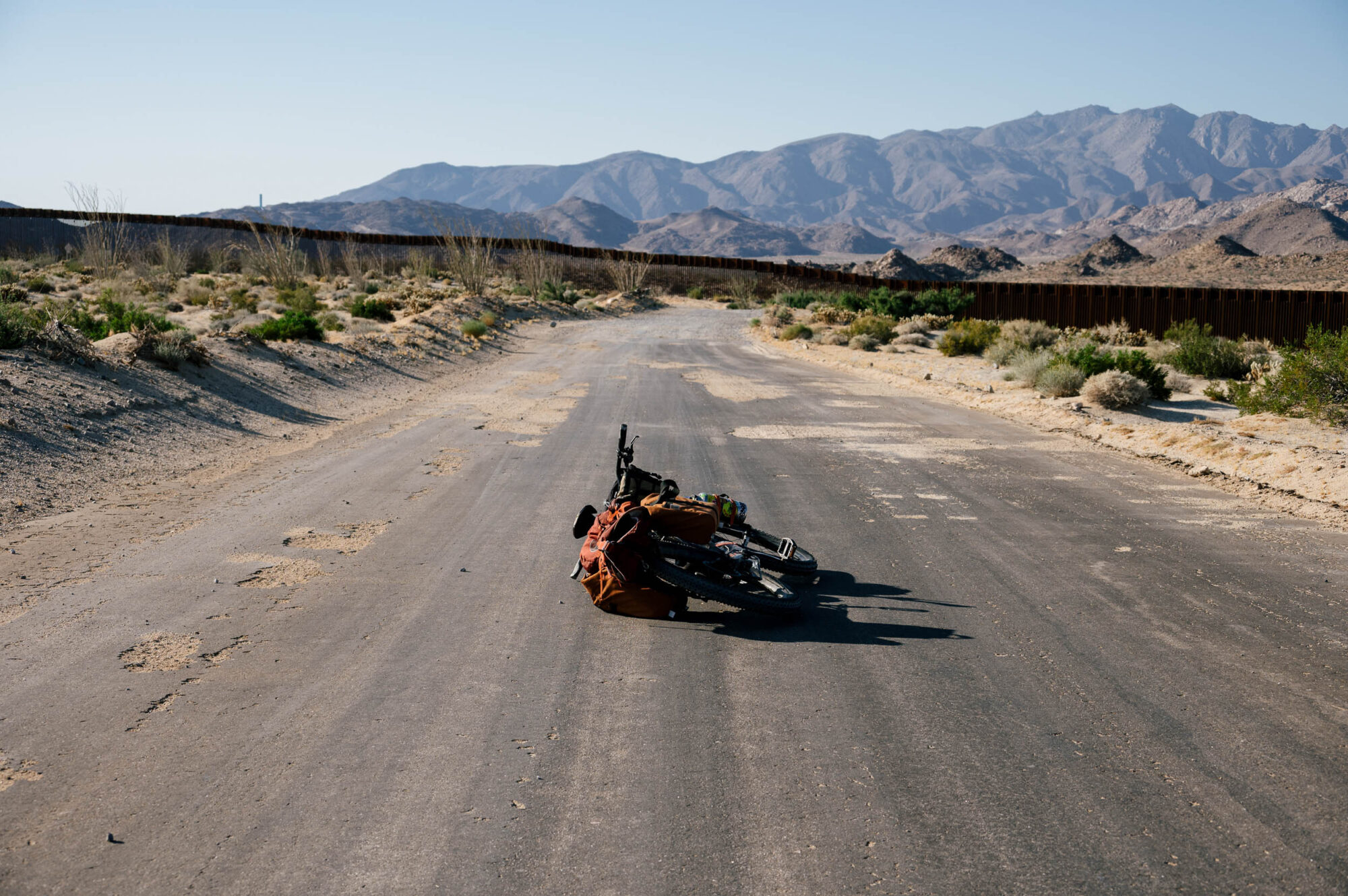
We ride out to the wall on a single paved road, just four years old and already cracking and torn up, the desert both desperate and powerful in reclaiming itself. The genesis of this project was staring at this road on a map, and realizing this is the lifeline to an otherwise untouchable area. It’s too far to access by foot, and the locked gate means they can’t drive the trucks in. The group had started using bikes a few years prior to access deeper parts of the backcountry, carrying even heavier loads along the way. They became a natural fit in their rotation of tools, and a refreshing way to mix up an often repetitive feeling task.
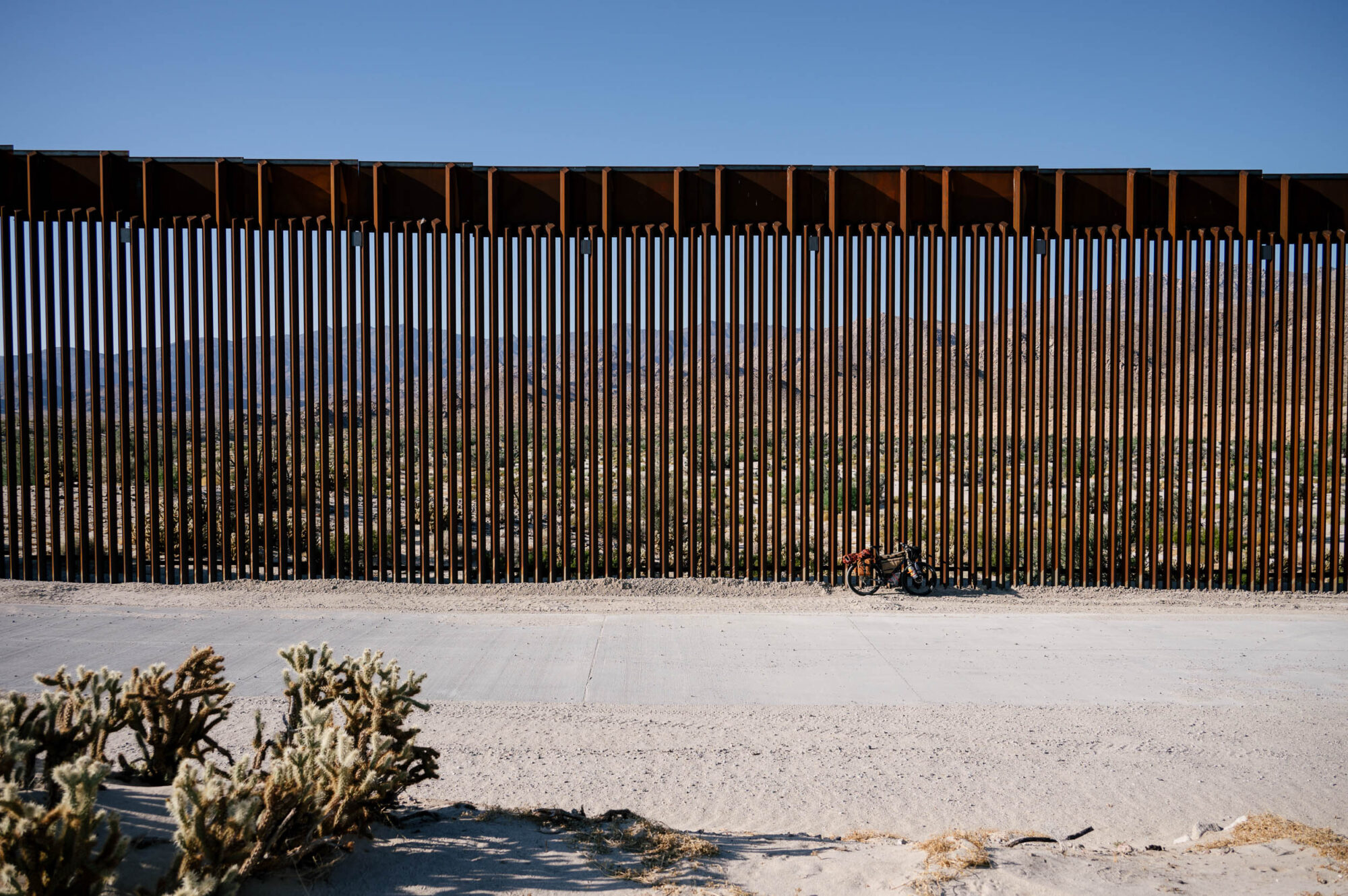
David’s always been a cyclist, racing in college and recreationally mountain biking throughout his years of drifting. He spearheaded the effort to bring bikes in. “My whole thing is you might as well have fun with it. Sometimes it’s real serious. Sometimes we’re crying together it’s so sad. But other times yeah, we’re laughing and we’re joking. The other aspect of the bike drops is that it is fun, and that it’s definitely allowed me to get to areas I never would have been to before, because there’s not like a really good reason to go to these places. They’re definitely some of the most remote places of Southern California that I know about.”
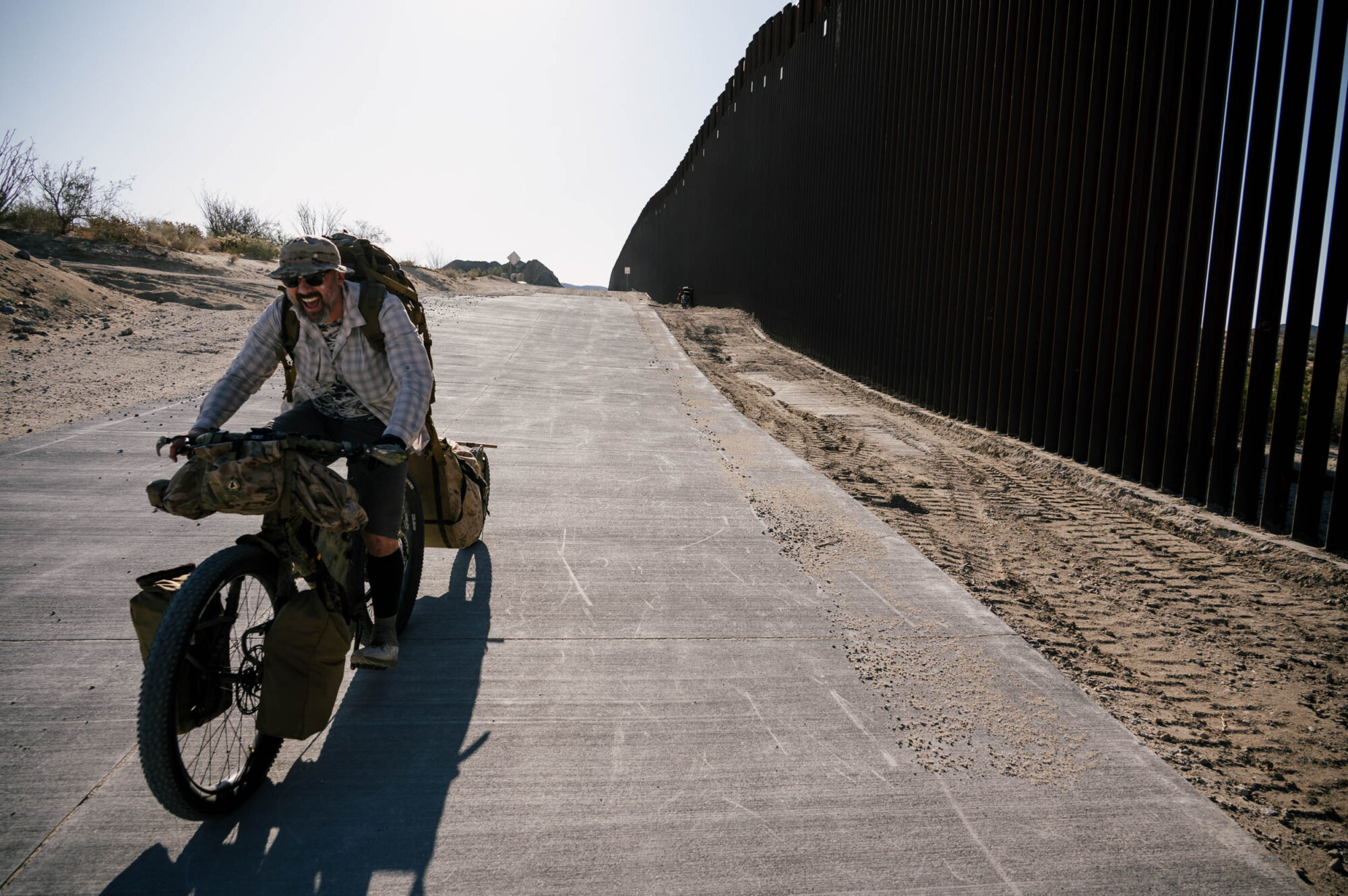
We bumble down the road, turn off, and connect with the canyon. The sand is soft and the boulders are strewn chaotically along the wash. The e-bikes zip ahead in the soft sand as I push and labor and grunt my way north. David bought them and the Frances Cycles Farfarer trailers after only a few runs here. They let the team carry far more water at a much lower energy cost, making the trip safer and more enjoyable for everyone involved. All the supplies are carried by the bikes and trailers until the terrain gets too demanding, and we push the bikes over the boulders to the first marker, a small blue cross the group left here in honor of Martin, a 24-year-old Father from Michoacán who died of hyperthermia two years ago. That same day, the Border Angels were doing a drop further up the same canyon, but ultimately turned around due to the unsafe heat, unaware of the man dying just a few miles away.
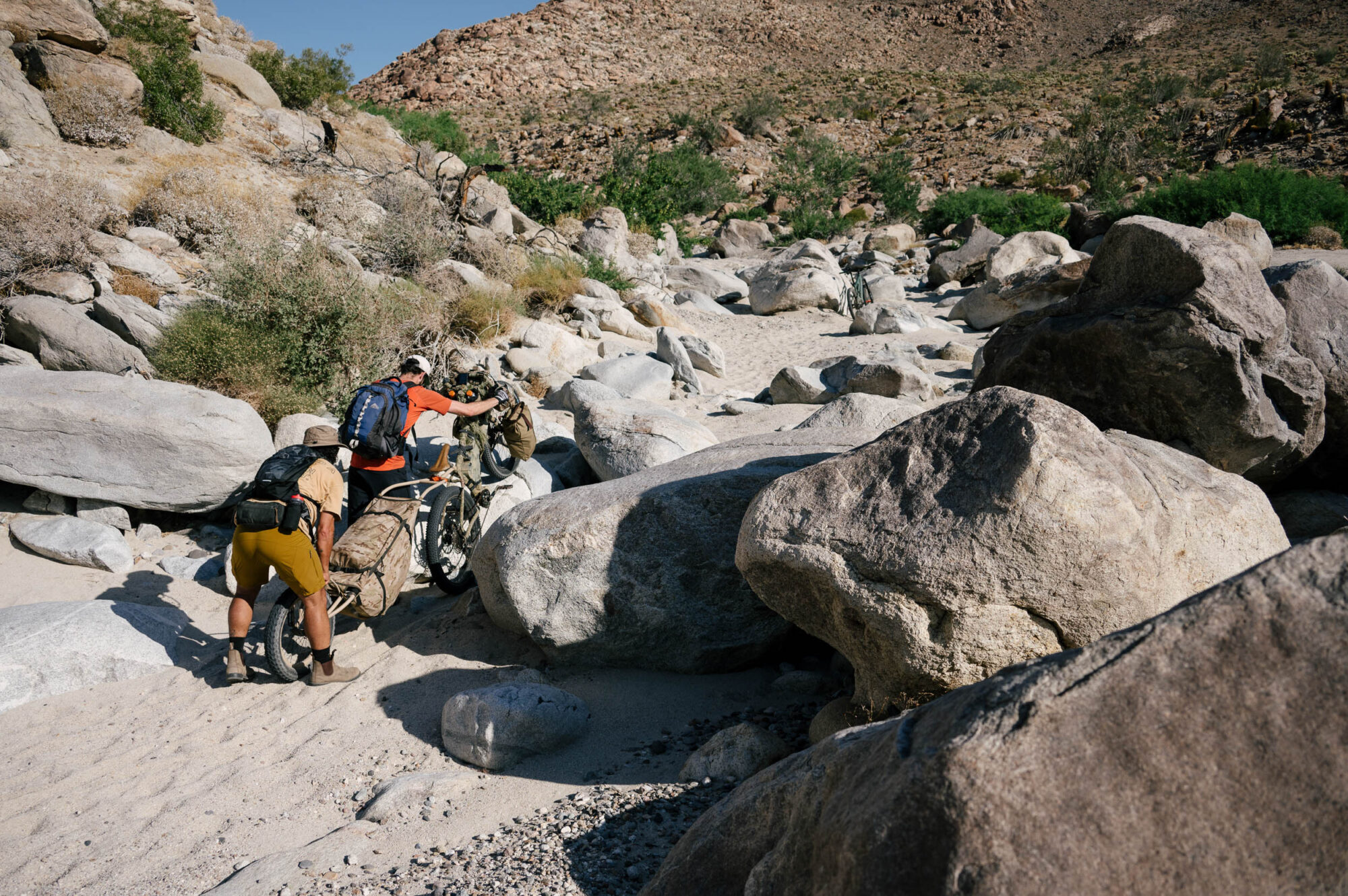
We unload the trailers at Martin’s cross, and count what’s been brought: 100 liters of water, 96 bottles of Gatorade, 112 cans of food, two medical kits and 18 bags with hats, socks and bandanas. We split it into thirds, pack the first into crates, and load the rest into our backpacks to begin the hike deep into the canyon. We sink into the sand and scramble over rocks and duck for shade wherever a sliver remains. It’s already over 100 degrees, and we keep several Gatorades for ourselves. My temples throb as the world gets quiet. The conversation is light, but the bags are not.
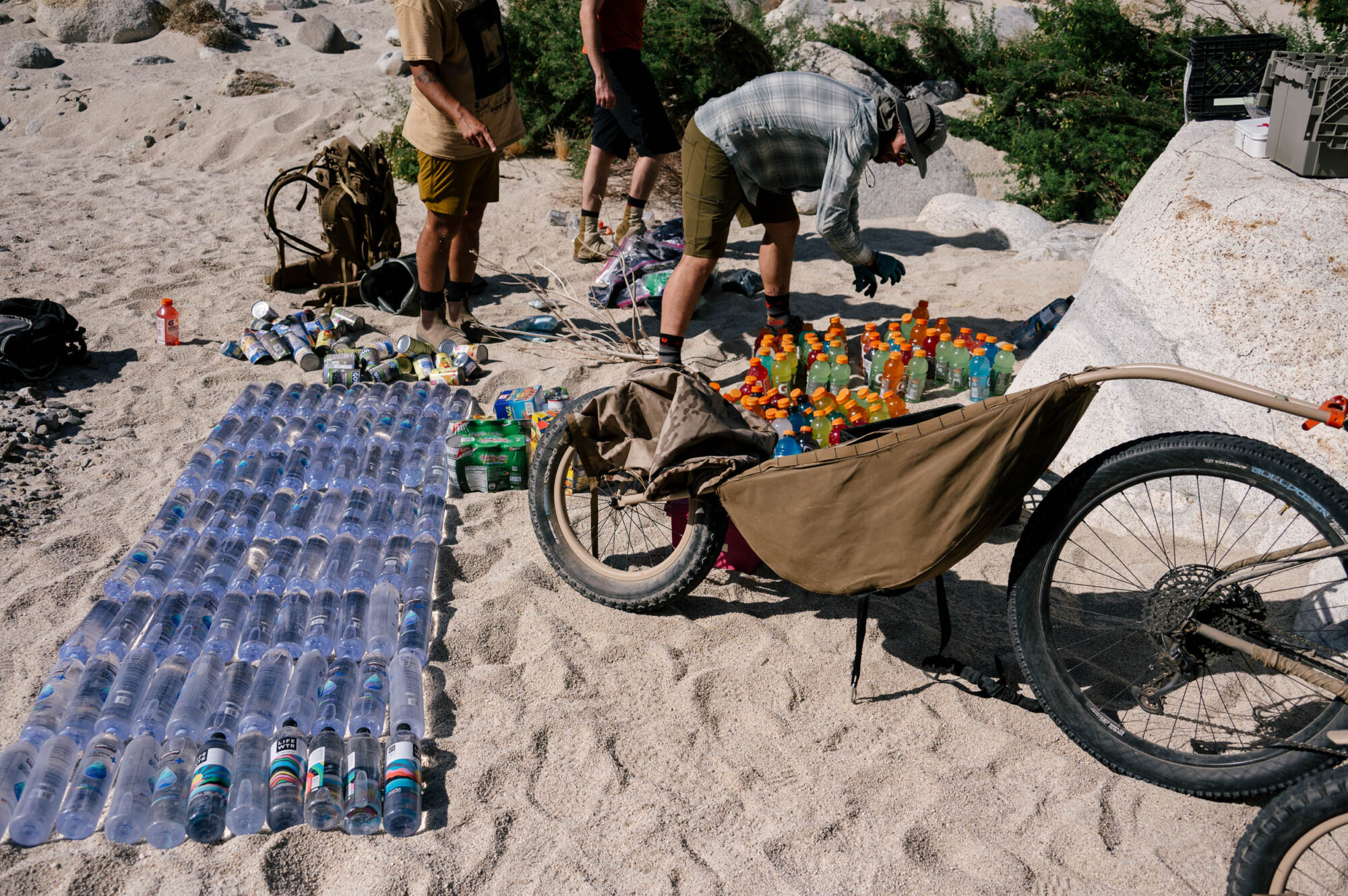
“Are you doing this for fun, or out of a sense that you need to be out here?” I ask the other members of the group. There are five of us today, more than what David is used to, but still not enough. “I mean… I would rather not be up at three and hiking in this heat,” says Dave, a car mechanic from Minnesota. “But, once you see how much of this stuff is needed you feel the need to come back here.”
So many members of the group are intimately tied to migration. Immigrant rights attorneys, environmentalists, the children of immigrants, even immigrants themselves. Daniel Gibson joins us in the desert on our scalding Saturday. He’s a regular on these bike drops now, having bought himself an e-bike and trailer to better keep up with the others in the group. Daniel’s dad was an immigrant from San Luis Río Colorado, a border town east of San Diego. He was brought over by Emmet Gibson, a switchman from the Southern Pacific Railroad, who became fond of the family while eating in their small taqueria back in the days of the gentle walks across the border. He later brought the whole family, including Daniel’s father, over to live with him.

Daniel later grew up in Plaster City and watched migrants stream across his yard. Now, he’s a successful artist in Los Angeles, painting beautiful murals inspired by scenes of the desert and the struggles of migration. We sit together in an exhausted stupor and he talks about his new piece and the challenges associated with it. It’s a portrait of his grandfather wearing two different suits, just how he used to do it when he was crossing. The tattered and dirty clothes of a migrant on top, and below, a business suit, pressed, professional, and respectable. He wanted to blend in after crossing and not be looked down on. He lived a life in hiding.
As we hike through the canyon and carry these water bottles, I think how foreign this world feels. This desert is so hostile, with its blinding light and sharp things, the rattlesnakes and the desert stretching to infinity. The only humanity left here is the military operation: the trucks, the searchlights, the helicopters. The days people spend walking across this landscape must be the most intimidating days of their lives. To leave the lush jungles of central Mexico or the quiet fishing villages of Venezuela and come through this hell in search of a better life must be the hardest decision anyone can make. Decisions with causes and effects and pain I can’t even begin to understand.
And as I empty my heavy backpack, and look up at the peaks that surround, teeming with cacti, cliffs, and brittle scree, I think of the hands on the other side of these water bottles: hands shrouded in the mystery of their own worlds, lives, and stories. Hands with callouses still packed with dirt from home. Hands clutching letters from loved ones, clutching whatever they can carry with them, hands clutching the hands of their children as they hike together. All around us, this wall, these guns, these cages scream you are not welcome here. This landscape screams you are not safe. But I hope someone takes this bottle of water and thinks that they are at least allowed to exist. Thousands of bodies remain abandoned in this desert. How would it feel to walk past that?
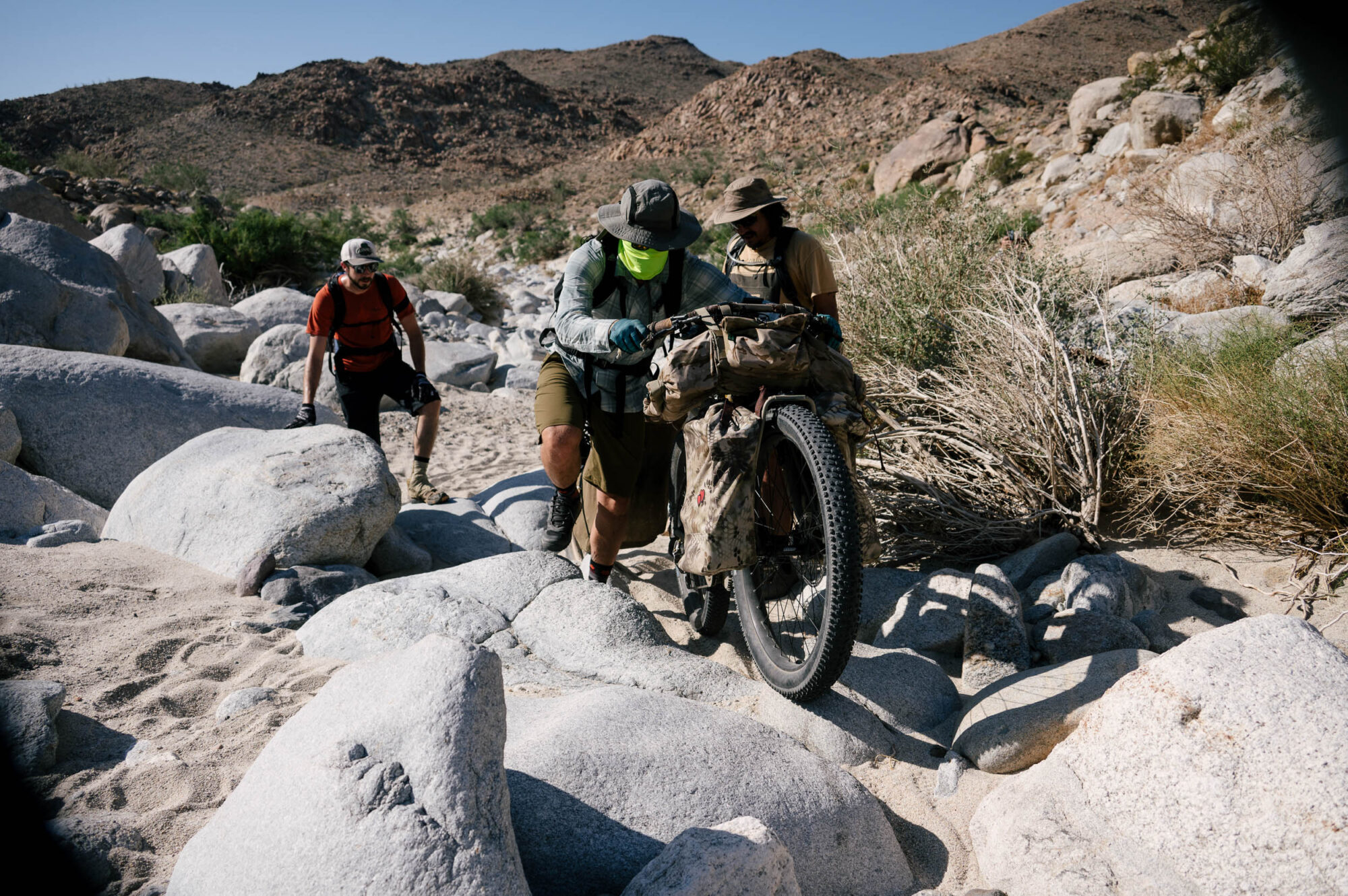
We empty the rest of our bags, hike back out, and get back on the road. I hold on as the e-bikes blast us away, away from the wall, away from the deep sand, back toward cold drinks and strong air conditioning. I hang on while Peter laughs, “My thumb is sore,” after holding the throttle for so long. We’re leaving after only seven hours, and I’ve already taken several steps into the deep cave of heat stroke. Tunnel vision, cramps, nausea, exhaustion. We get back, David is already getting ready for another drop the next day. The gas station has a wall full of cold beer. I stare in a daze. My head pounds and my back aches.
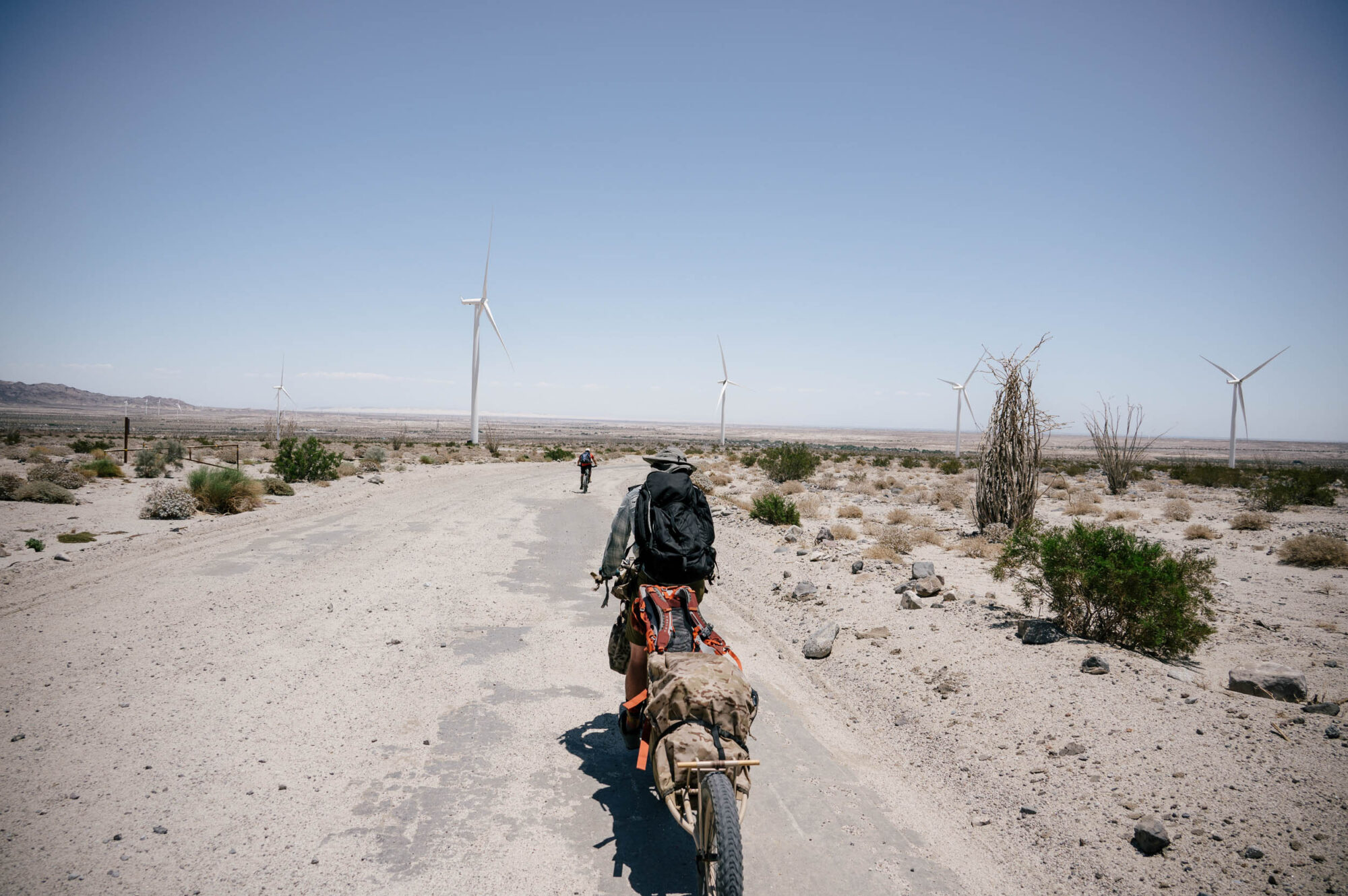
A refrigerator in this beast of a desert is a unit of hope. I think how cold beer and salty chips would taste amazing after a week in the desert. I wonder if it’s worth being arrested and deported for a cold drink after that walk. Do they gamble everything, or crawl into dusty drainages and push further north first? I wonder how deep this cave of heat stroke goes, although we all know what waits on the other side. The hard shadows of metal crosses cut sand in the many corners of this canyon, and death flutters on the wings of vultures soaring over the desert as the sun rises and the sun sets. David and crew, with these bikes and these hot bottles of water are there so fewer people and fewer families end up marching themselves to death. I grab a coconut water and head home. I wonder why it has to be this way.
If you’d like to see more from Borderlands Relief Collective, you can find them on Instagram at @borderlandsreliefcollective and @borderland_bike_drops. If you want to donate money to aid in the purchasing of supplies, you can venmo the treasurer @skaiheitz.
Please keep the conversation civil, constructive, and inclusive, or your comment will be removed.








